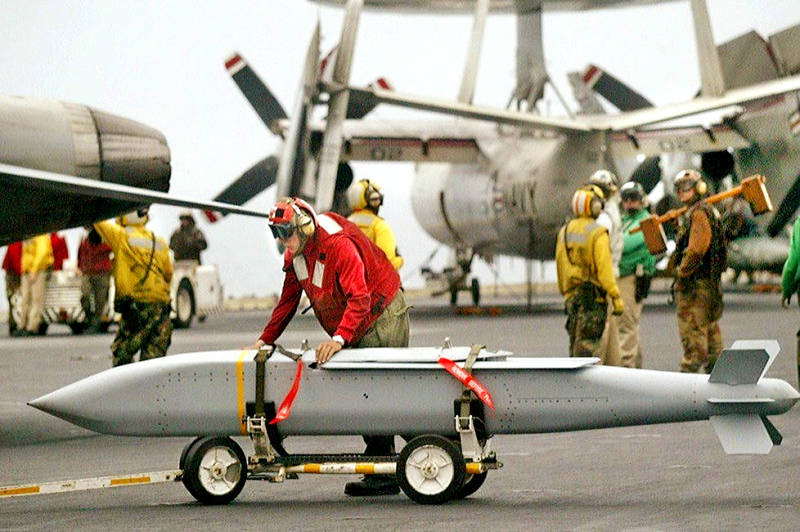《TAIPEI TIMES》 US to deliver 50 AGM-154 glide bombs

A US Navy ordinance handler pushes a Joint Standoff Weapon across the flight deck of the USS “Kitty Hawk” in northern Persian Gulf on March 25, 2003. Photo: AFP
COMBAT CAPABILITIES: The glide bombs are part of a larger arms package including AGM-88 HARMs, and other weapons compatible with F-16 jets and their upgrades
By Chen Cheng-liang and William Hetherington / Staff reporter, with staff writer
The US Department of Defense is to partner with RTX Corp, formerly Raytheon Technologies Corp, to deliver 50 AGM-154 Joint Standoff Weapons (JSOW), or glide bombs, to Taiwan over the next four years, a report published on Friday showed.
The report, published on the department’s Web site on Friday, said that 50 AGM-154 Block III C JSOWs would be delivered to Taiwan under a fixed-price contract worth US$68.4 million.
Most of the production of the weapons would be done in Tucson, Arizona, and would be completed by March 2028, the report said.
The report comes after Reuters on Thursday quoted US officials as saying that the US military had left equipment in Australia following last year’s Talisman Sabre 23 joint exercise, with the intention that it could be used by US forces in the event of a conflict with China over Taiwan.
The glide bombs are part of a larger arms package of seven items initially announced by the US in June 2017. It also included the AGM-88 HARM (High-speed Anti-radiation Missile) and other weapons that could be used with Taiwan’s F-16 jets. The weapons were intended to complement other upgrades to Taiwan’s F-16 fleet, which also included radar and communications system upgrades.
The AGM-154 is a JSOW that emerged through the US Navy’s Advanced Interdiction Weapon System program launched in 1987, which sought to develop weapons that are usable day or night, and in any weather conditions.
The JSOWs designed for the program are “fire and forget” weapons, meaning they do not require external guidance after launch. Instead, they navigate to their targets via a GPS/inertial navigation system. JSOW weapons have been replacing conventional laser-guided bombs, and the newest JSOW weapons also incorporate infrared guidance systems.
JSOW weapons dropped at high altitude can reach targets as far as 110km away, and those launched at low altitude can strike up to 22km away, which would enhance the F-16 jet’s land attack capabilities.
Countries other than the US that are purchasing AGM-154 glide bombs include Taiwan, Australia, Finland, Greece, Poland, Singapore and Turkey.
Taiwan has facilitated the incorporation of the weapons into its fleet by upgrading its older F-16A/B fighter jets to the F-16V variant through the Phoenix Rising Project and through the purchase of newer Block 70 fighters.
The upgraded jets as well as the Block 70 fighters can carry AGM-154C glide bombs, which could help diversify the Taiwanese air force’s air-to-ground combat capabilities.
新聞來源:TAIPEI TIMES











